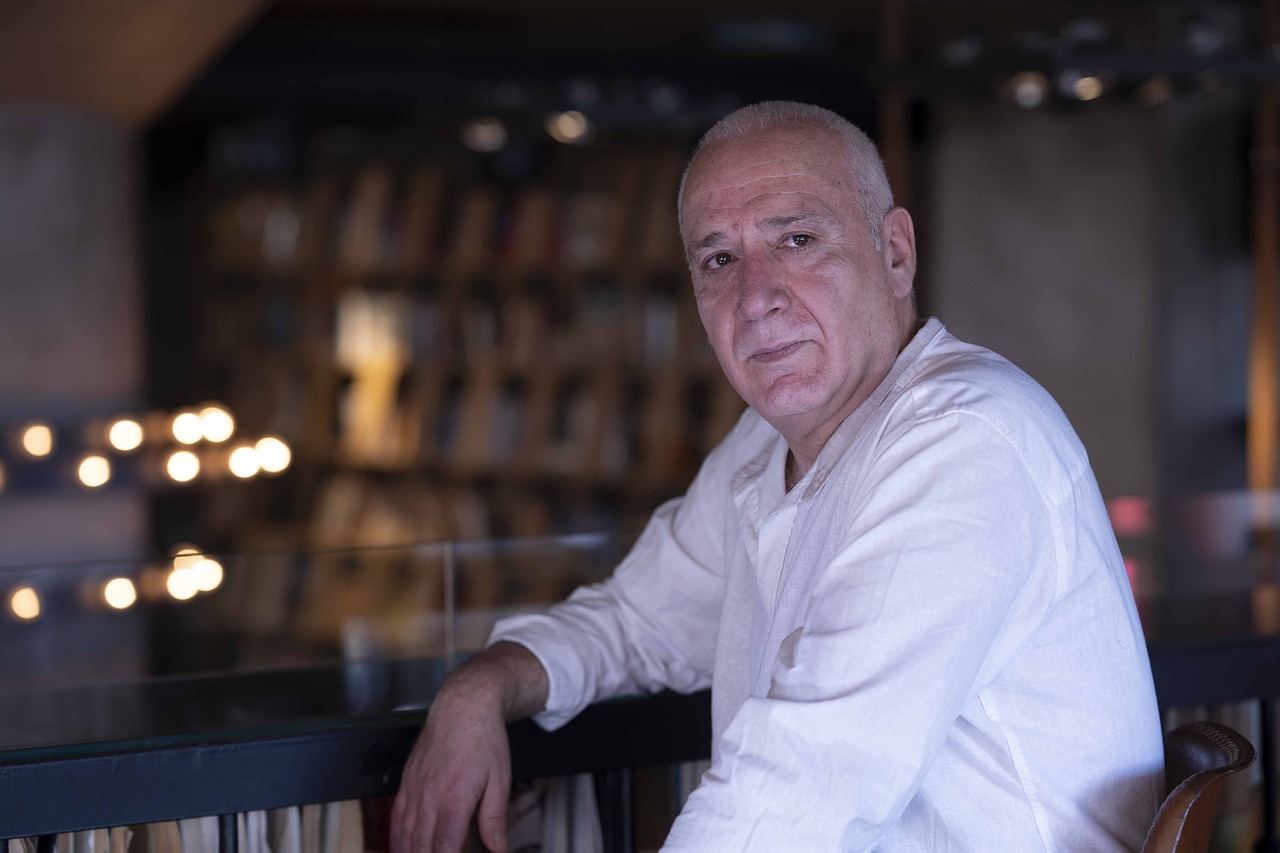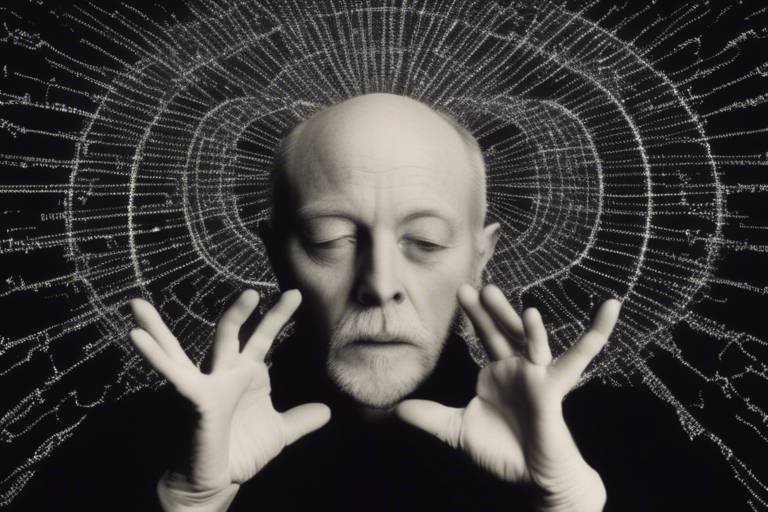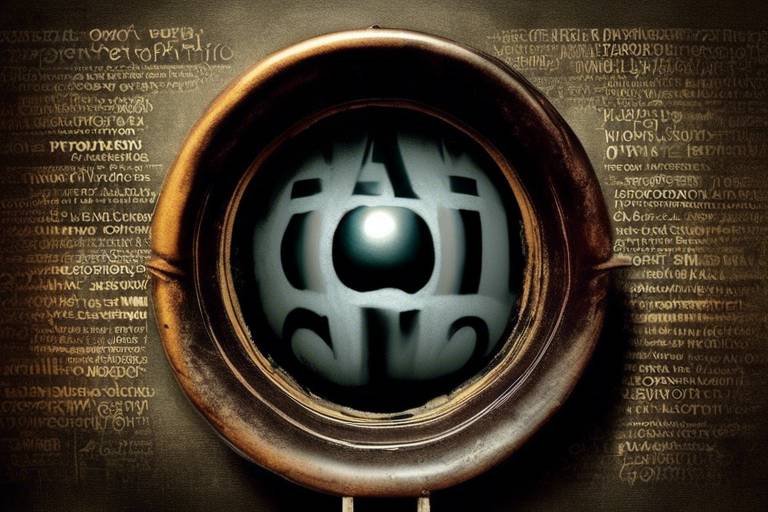Understanding the Metaphysics of Truth
The concept of truth is one of the most profound and perplexing topics in metaphysical philosophy. It’s not just a simple word; it’s a gateway to understanding how we perceive reality, communicate with one another, and build our belief systems. Imagine truth as a multifaceted gem, each facet reflecting different aspects of our existence. What does it mean to say something is true? Is it merely a reflection of agreement between statements and reality, or does it hold deeper implications for our understanding of knowledge and belief?
In our quest to grasp the essence of truth, we must first recognize its fundamental characteristics. Truth is often perceived as an objective reality, something that exists independently of our beliefs or perceptions. However, this notion can be challenged when we consider the subjective experiences that shape our understanding. For instance, think about how different cultures may interpret the same event in vastly different ways. This variability raises questions about the universality of truth and whether it can ever be fully grasped.
Moreover, the significance of truth extends far beyond philosophical musings; it plays a crucial role in human cognition and communication. Truth is the bedrock of trust in relationships, the foundation of ethical reasoning, and the guiding principle in scientific inquiry. Without a shared understanding of what is true, how can we engage in meaningful dialogue or pursue knowledge effectively? This inquiry into the nature of truth invites us to reflect on our own beliefs and the frameworks through which we interpret the world.
As we embark on this exploration of truth, we will delve into various theories that have emerged throughout history, each offering unique insights and challenges. From the correspondence theory, which posits that truth is a reflection of reality, to the coherence theory, which emphasizes internal consistency among beliefs, and the pragmatic theory, which focuses on the practical consequences of beliefs, each theory provides a different lens through which to examine the complex nature of truth. Throughout this article, we will not only dissect these theories but also consider their implications for our understanding of knowledge and belief systems.
In essence, the metaphysics of truth is not just an academic exercise; it is a vital inquiry that affects how we live our lives. By understanding the various dimensions of truth, we can better navigate the complexities of our reality and foster deeper connections with others. So, let’s dive deeper into the nature of truth and explore the theories that have shaped our philosophical landscape.
Truth is often seen as a guiding principle in our lives, yet its nature can be elusive. It’s essential to explore how truth is perceived across different philosophical contexts. Some philosophers argue that truth is an absolute concept, while others contend that it is relative, shaped by cultural and individual perspectives. This dichotomy leads us to ponder: can truth ever truly be objective, or is it always colored by our experiences and biases?
As we dissect the nature of truth, we must consider its significance in human cognition and communication. Truth is not just about factual accuracy; it’s about the trust and reliability that underpin our interactions. When we communicate, we rely on the assumption that our statements reflect reality. This assumption is what allows us to engage in meaningful discourse. However, what happens when that trust is broken? The implications can be profound, affecting everything from personal relationships to societal structures.
Now that we’ve laid the groundwork for understanding the nature of truth, it’s time to explore the various theories that have emerged to explain it. Each theory comes with its own strengths and weaknesses, providing a rich tapestry of thought for philosophical inquiry. Let’s take a closer look at three major theories: correspondence, coherence, and pragmatic theories. Each theory not only shapes our understanding of truth but also influences our approach to knowledge and belief.
The correspondence theory posits that truth is determined by the relationship between statements and the world. In other words, a statement is true if it accurately describes a fact or state of affairs in reality. This theory has deep historical roots, tracing back to philosophers like Aristotle, who believed that truth is a matter of accurately reflecting the world around us.
Despite its popularity, the correspondence theory faces significant critiques. Critics argue that it oversimplifies the complex nature of truth by reducing it to mere factual accuracy. For instance, how do we account for subjective experiences that may not correspond to objective reality? This part of the discussion invites alternative perspectives that challenge the validity of the correspondence theory.
In practical terms, the correspondence theory finds applications in various disciplines, including science, law, and everyday reasoning. In science, for example, the theory underpins the scientific method, where hypotheses are tested against observable facts. In law, the correspondence between evidence and claims is crucial for establishing guilt or innocence. These applications illustrate how the theory shapes our understanding of factual claims in real-world scenarios.
On the other hand, coherence theory suggests that truth is a matter of consistency within a set of beliefs or propositions. This perspective emphasizes the interconnectedness of our beliefs and how they form a coherent system. When we evaluate the truth of a statement, we consider how well it fits within our existing framework of understanding. This approach has significant implications for epistemology, particularly in how we assess belief systems.
The pragmatic theory shifts the focus from correspondence and coherence to the practical consequences of beliefs. According to this theory, a belief is true if it proves useful or beneficial in real-life situations. This perspective invites us to consider how our understanding of truth is influenced by context and action. For instance, a scientific theory may be deemed true not just because it corresponds to reality, but because it effectively predicts outcomes and solves problems.
Ultimately, the pragmatic theory affects our conception of knowledge, particularly in relation to truth's utility. It prompts us to ask: what does it mean for something to be true? Is it enough for a belief to be accurate, or must it also serve a purpose? This inquiry highlights the importance of context in determining what we consider true, suggesting that our understanding of truth is as dynamic as the world around us.
- What is the nature of truth? Truth is a complex concept that can be perceived as objective or subjective, depending on cultural and individual perspectives.
- What are the main theories of truth? The main theories include correspondence theory, coherence theory, and pragmatic theory, each offering unique insights into the nature of truth.
- How does correspondence theory apply in real life? Correspondence theory is applied in fields like science and law, where factual accuracy is essential for establishing claims and hypotheses.
- What is the significance of pragmatic theory? Pragmatic theory emphasizes the practical consequences of beliefs, suggesting that truth is determined by its usefulness in real-life situations.

The Nature of Truth
Truth is a concept that has puzzled philosophers, scientists, and thinkers for centuries. What exactly is truth? Is it an objective reality that exists independent of our perceptions, or is it something more subjective, shaped by our beliefs and experiences? Understanding the nature of truth is crucial because it influences how we communicate, make decisions, and interact with the world around us. Imagine truth as a multifaceted gem, where each facet reflects a different angle of understanding. Depending on how you look at it, you might see something entirely different.
In essence, truth can be perceived through various lenses, each offering unique insights. For instance, in everyday conversation, we often equate truth with factual accuracy. When someone states a fact, we instinctively consider it true if it aligns with our understanding of reality. However, this perspective can be limiting. Truth isn't just about what can be empirically verified; it also encompasses deeper philosophical inquiries. Think about how different cultures interpret truth. In some traditions, truth is tied to moral principles, while in others, it may be linked to community consensus.
Moreover, the significance of truth extends beyond mere definitions. It plays a pivotal role in human cognition and communication. When we convey information, we rely on our perception of truth to establish trust and credibility. If we constantly question the truthfulness of our interactions, it can lead to a breakdown in relationships and societal structures. This brings us to a critical point: truth is not just an abstract concept; it is a cornerstone of our social fabric.
To further illustrate the complexity of truth, consider the following characteristics:
- Subjectivity vs. Objectivity: Truth can be subjective, varying from person to person, or objective, existing independently of individual beliefs.
- Contextual Nature: The context in which a statement is made can significantly affect its truth value. What is true in one scenario may not hold in another.
- Dynamic Process: Truth is not static; it evolves as new information and perspectives emerge. This fluidity can lead to heated debates and discussions.
In conclusion, the nature of truth is a complex interplay of various factors, including perception, culture, and context. As we navigate through life, our understanding of truth shapes our beliefs and actions. It's essential to remain open-minded and critical, recognizing that our grasp of truth may evolve over time. By doing so, we can foster richer conversations and deeper connections with others, ultimately leading to a more profound understanding of the world around us.

Theories of Truth
When diving into the realm of metaphysics, one quickly realizes that the concept of truth is not as straightforward as it seems. Various theories have emerged over the centuries, each attempting to decode the intricate nature of truth. These theories not only reflect the philosophical zeitgeist of their time but also influence how we perceive reality and communicate with one another. Understanding these theories is crucial, as they shape our beliefs, guide our actions, and ultimately determine how we navigate the complexities of life.
At the heart of the discussion are three predominant theories: correspondence theory, coherence theory, and pragmatic theory. Each of these theories offers a unique lens through which to view truth, presenting their own strengths and weaknesses. Let’s explore these theories further, starting with the correspondence theory.
The correspondence theory asserts that truth is defined by the relationship between statements and the world. In other words, a statement is true if it accurately reflects the reality it describes. Think of it as a mirror: if you look into a mirror and see your reflection, it’s true because it corresponds to your actual self. This theory has historical roots dating back to philosophers like Aristotle, who believed that truth is a matter of how things are in the world. However, while this theory is intuitive and widely accepted, it does face significant critiques, especially regarding its applicability in complex scenarios where reality is not so easily defined.
On the flip side, we have the coherence theory, which suggests that truth is not about individual statements but rather about the consistency of a set of beliefs or propositions. Imagine a web: each belief is a strand, and for the web to hold together, all strands must be interlinked and support one another. This theory emphasizes the importance of a cohesive belief system, suggesting that if a belief fits harmoniously within a larger framework, it can be considered true. However, this raises questions about the validity of belief systems themselves, especially if they are based on flawed premises.
Lastly, the pragmatic theory of truth shifts the focus from abstract definitions to practical consequences. It posits that the truth of a belief is determined by its usefulness and the outcomes it produces. Picture this: if a belief leads to successful actions and results, it is deemed true. This theory aligns well with everyday experiences, where the effectiveness of our beliefs often dictates our understanding of truth. However, it can also lead to subjective interpretations, as what works for one person may not work for another, creating a potential quagmire in establishing universal truths.
In summary, understanding these theories of truth is essential for anyone delving into philosophical inquiry. Each theory offers unique insights into how we construct our understanding of reality. As we navigate through life, these theories not only inform our beliefs but also shape our actions and interactions with others. So, which theory resonates with you? Are you more inclined to believe in the correspondence of statements to reality, the coherence of beliefs within a system, or the pragmatic outcomes of your actions?
- What is the correspondence theory of truth? The correspondence theory posits that a statement is true if it accurately reflects reality.
- How does coherence theory differ from correspondence theory? Coherence theory suggests that truth is determined by the consistency and interrelation of a set of beliefs, rather than their correspondence to reality.
- What is the pragmatic theory of truth? The pragmatic theory emphasizes the practical consequences of beliefs as a measure of their truthfulness.
- Why is understanding theories of truth important? These theories shape our beliefs, guide our actions, and influence how we communicate and interact with the world.

Correspondence Theory
The of truth is one of the most traditional and widely discussed theories in the realm of metaphysical philosophy. At its core, this theory asserts that truth is fundamentally about the relationship between statements and the world they describe. In simpler terms, a statement is considered true if it accurately reflects reality. Imagine it as a mirror: just as a mirror reflects the physical world, a true statement reflects the state of affairs in the world. This notion has been a significant cornerstone in our understanding of truth since ancient times, with roots tracing back to philosophers like Aristotle, who famously stated that "to say of what is that it is not, or of what is not that it is, is false, while to say of what is that it is, and of what is not that it is not, is true."
In contemporary discussions, the correspondence theory remains relevant, particularly in fields such as science and law, where factual accuracy is paramount. For instance, when a scientist claims that "water boils at 100 degrees Celsius," this statement is deemed true because it corresponds with empirical observations of water's behavior under specific conditions. The theory posits that truth is not merely subjective or relative; rather, it has an objective basis rooted in the world itself.
However, the correspondence theory is not without its challenges. Critics argue that the relationship between language and reality is more complex than the theory suggests. For example, consider the statement "unicorns exist." While this statement can be evaluated for its truthfulness, the absence of unicorns in reality raises questions about how we determine truth when the subject matter is non-existent. This leads to deeper inquiries about the nature of reality and how our perceptions shape our understanding of truth.
To further illustrate the implications of the correspondence theory, let’s examine a few key aspects:
| Aspect | Description |
|---|---|
| Objective Reality | The theory asserts that truth is grounded in an objective reality that exists independently of our beliefs. |
| Empirical Verification | Truth claims can be tested and verified through observation and experimentation. |
| Language and Meaning | The clarity of language is crucial; ambiguous statements can lead to confusion about their truth value. |
In summary, the correspondence theory offers a compelling framework for understanding truth, emphasizing the importance of an objective reality that our statements aim to reflect. However, as we navigate the complexities of language and perception, it becomes clear that our quest for truth is an ongoing journey, one that requires us to constantly evaluate and refine our understanding of the world around us.

Critiques of Correspondence Theory
The correspondence theory of truth, while widely accepted, is not without its critics. One major critique stems from the theory's reliance on a clear relationship between statements and the world. Critics argue that this relationship is often ambiguous and subjective. For instance, how do we ascertain what is "real" in a world filled with perceptions and interpretations? This leads to the question: is our understanding of truth merely a reflection of our beliefs rather than an objective reality?
Another significant challenge to the correspondence theory is the problem of incompleteness. The theory assumes that every statement can be matched with a corresponding fact. However, many philosophical and scientific inquiries reveal that not all truths can be easily categorized. For example, consider abstract concepts like beauty or justice. Can we truly say that a statement about beauty corresponds to a specific fact in the world? This ambiguity raises doubts about the theory's applicability in various contexts.
Moreover, the correspondence theory faces the issue of contextuality. Truth can be context-dependent, varying across different cultures, languages, and situations. What may be considered true in one context might not hold in another. This raises an important question: if truth is not universal, can we still rely on the correspondence theory to provide a consistent framework for understanding truth across diverse perspectives?
To illustrate these critiques further, consider the following table that summarizes some of the key objections to the correspondence theory:
| Critique | Description |
|---|---|
| Ambiguity | The relationship between statements and reality is often unclear and subjective. |
| Incompleteness | Not all truths can be easily matched with corresponding facts. |
| Contextuality | Truth varies across different cultures and contexts, challenging the notion of universal truth. |
Furthermore, some philosophers argue that the correspondence theory fails to account for the role of language in shaping our understanding of truth. Language is inherently limited and can distort the reality it attempts to describe. This raises the question: if our linguistic frameworks are flawed, how can we trust that our statements accurately correspond to the world? This critique emphasizes the need for a more nuanced understanding of truth that considers the complexities of language and human cognition.
In conclusion, while the correspondence theory offers a compelling perspective on truth, its limitations and critiques highlight the need for ongoing philosophical exploration. The nature of truth is complex and multifaceted, inviting us to question our assumptions and consider alternative theories that may better capture the essence of what it means to be "true."
- What is the correspondence theory of truth? The correspondence theory posits that truth is determined by the relationship between statements and the world.
- What are some critiques of the correspondence theory? Critics argue that the theory is ambiguous, incomplete, and fails to account for the contextuality of truth.
- How does language impact our understanding of truth? Language can distort reality, leading to questions about the accuracy of statements made about the world.
- Are there alternative theories of truth? Yes, theories such as coherence theory and pragmatic theory offer different perspectives on the nature of truth.

Applications of Correspondence Theory
The correspondence theory of truth is not just a dusty old concept confined to the pages of philosophical texts; it has real-world applications that shape our understanding of various fields. At its core, this theory asserts that a statement is true if it accurately reflects the state of affairs in the world. But how does this play out in practical scenarios? Let’s dive into some compelling examples.
In the realm of science, correspondence theory is fundamental. Scientists formulate hypotheses and conduct experiments to test their claims against observable phenomena. For instance, if a physicist states, “Water boils at 100 degrees Celsius at sea level,” this statement is true if, and only if, it corresponds to the actual boiling point of water under those conditions. This relationship between statements and reality is crucial for scientific progress, as it ensures that theories are grounded in empirical evidence.
Similarly, in the field of law, correspondence theory plays a vital role. Legal statements or claims must correspond to the facts of a case to be deemed valid. For example, if a witness testifies that they saw a defendant at the scene of a crime, the truth of that statement hinges on whether it accurately reflects what actually occurred. The legal system relies heavily on this correspondence to establish accountability and justice. Without this principle, the very foundation of legal reasoning would crumble, leading to chaos and uncertainty.
Everyday reasoning also relies on correspondence theory. When we make claims about our day-to-day experiences, we expect them to align with reality. For instance, if you tell a friend, “I saw a beautiful sunset yesterday,” the truth of your statement is contingent upon whether or not that sunset actually occurred. This alignment between our statements and the world around us is what fosters effective communication and builds trust in our interactions.
Moreover, correspondence theory has implications in journalism. Journalists strive to report facts accurately, ensuring that their articles correspond to the actual events they cover. This commitment to truth underpins the credibility of news organizations and is essential for an informed public. When news outlets fail to adhere to this principle, they risk spreading misinformation, which can have serious consequences for society.
To illustrate these applications more clearly, here’s a simple table highlighting how correspondence theory operates across different fields:
| Field | Application |
|---|---|
| Science | Testing hypotheses against observable phenomena |
| Law | Establishing facts to support legal claims |
| Everyday Reasoning | Ensuring statements about experiences align with reality |
| Journalism | Reporting facts accurately to maintain credibility |
In summary, the applications of correspondence theory extend far beyond abstract philosophical discussions. They permeate various domains, influencing how we perceive truth and ensuring that our statements about the world hold water. Whether in science, law, or daily life, the need for our claims to correspond with reality remains a cornerstone of rational thought and effective communication.
- What is correspondence theory?
Correspondence theory posits that the truth of a statement is determined by its relation to the world; it is true if it accurately describes a fact or state of affairs.
- How does correspondence theory apply in science?
In science, hypotheses must be tested against empirical evidence to determine their truth. If a hypothesis corresponds to observable realities, it is considered true.
- Why is correspondence theory important in law?
In law, statements must correspond to the actual facts of a case to be valid. This ensures justice and accountability within the legal system.
- Can correspondence theory be challenged?
Yes, while widely accepted, correspondence theory faces critiques regarding its applicability in complex or subjective contexts, leading to alternative theories of truth.

Coherence Theory
The Coherence Theory of Truth presents a fascinating perspective on how we understand and determine what is true. Unlike the correspondence theory, which anchors truth in the relationship between statements and the external world, coherence theory suggests that truth is a matter of internal consistency among a set of beliefs or propositions. Imagine a puzzle: each piece represents a belief, and the picture only comes together when all pieces fit harmoniously. This theory emphasizes that for a belief to be considered true, it must not only stand alone but also cohere with other beliefs within a larger system.
One of the most compelling aspects of coherence theory is its implications for epistemology, the study of knowledge. It prompts us to ask questions like: How do our beliefs interact? What happens when new information challenges our existing beliefs? In this light, coherence theory encourages a dynamic view of truth, where beliefs are constantly adjusted and reevaluated in light of new experiences and information. This means that truth is not a static entity but rather a fluid concept shaped by the ever-evolving landscape of our understanding.
However, coherence theory is not without its challenges. Critics argue that just because a set of beliefs is consistent does not necessarily mean that they are true. For instance, a group of individuals might share a coherent belief system based on misinformation or faulty reasoning. This raises critical questions about the reliability of coherence as a measure of truth. To illustrate this, consider a scenario where a community believes in a conspiracy theory. Their beliefs may be coherent and consistent with one another, yet they might not reflect the actual state of affairs. This highlights a significant limitation of coherence theory: it can potentially validate falsehoods if they are internally consistent.
Despite these critiques, coherence theory has valuable applications, particularly in fields like philosophy, science, and law. In philosophy, for example, it encourages a holistic approach to understanding concepts and arguments. In science, researchers often rely on a coherent framework of theories to interpret data and draw conclusions. In legal contexts, the coherence of evidence and testimonies is crucial for establishing the truth in court cases. Thus, while coherence theory may face scrutiny, its relevance in practical applications cannot be dismissed.
In conclusion, coherence theory offers a unique lens through which we can examine truth. It challenges us to consider the interconnectedness of our beliefs and the importance of consistency in our understanding of reality. While it has its limitations, the theory remains a vital part of the philosophical discourse surrounding truth. As we navigate through complex ideas and beliefs, coherence theory reminds us that truth is often a tapestry woven from the threads of our collective understanding.
- What is coherence theory? Coherence theory posits that truth is determined by the consistency and interconnectedness of beliefs within a system.
- How does coherence theory differ from correspondence theory? While correspondence theory focuses on the relationship between statements and the external world, coherence theory emphasizes internal consistency among beliefs.
- What are the implications of coherence theory in everyday life? Coherence theory encourages individuals to evaluate their beliefs in relation to one another, promoting a more holistic understanding of truth.
- Can coherence theory validate false beliefs? Yes, coherence theory can potentially validate falsehoods if a set of beliefs is consistent but not aligned with reality.

Pragmatic Theory of Truth
The offers a refreshing perspective on how we understand and evaluate truth. Unlike traditional theories that often anchor truth in abstract principles, the pragmatic approach roots it in the practical consequences of our beliefs and statements. Imagine you're trying to navigate through a dense fog; the clarity of your path is determined not by the fog itself, but by the steps you take and the outcomes you achieve. This is the essence of pragmatism—truth is what works in real-life situations.
At the heart of the pragmatic theory is the idea that the value of a belief lies in its usefulness and effectiveness. When we assert something to be true, we are essentially saying that believing it leads to successful action or outcomes. For instance, consider the statement "exercise is beneficial for health." This isn't just a theoretical claim; its truth is validated through the tangible benefits people experience when they engage in regular physical activity. In this sense, the pragmatic theory emphasizes that truth is not static; it evolves as we interact with the world and gather experiences.
One of the most compelling aspects of the pragmatic theory is its acknowledgment of context. Truth can vary based on circumstances, and what may be true in one situation might not hold in another. This can be illustrated through the example of a tool. A hammer is 'true' as a tool for driving nails, but if you attempt to use it to cut a piece of wood, its truth as a cutting tool vanishes. Thus, the pragmatic theory encourages us to consider the broader context in which a belief operates, highlighting the dynamic nature of truth.
However, it's essential to note that the pragmatic theory is not without its critics. Some argue that it risks reducing truth to mere opinion or subjective experience. If truth is solely determined by practical outcomes, does that mean harmful beliefs can be considered 'true' if they yield certain results? This question opens a Pandora's box of ethical considerations, challenging us to reflect on the implications of our beliefs and their consequences.
Despite these critiques, the pragmatic theory has profound implications for various fields, including education, science, and philosophy. In education, for instance, a pragmatic approach encourages teaching methods that prioritize experiential learning. Students are more likely to retain knowledge when they see its practical application in the real world. Similarly, in scientific inquiry, hypotheses are often evaluated based on their predictive power and the success of their applications, aligning closely with pragmatic principles.
In conclusion, the pragmatic theory of truth invites us to rethink our approach to understanding what is true. It champions the idea that truth is not merely a static concept but a lively, evolving entity shaped by our actions and experiences. By focusing on the practical consequences of our beliefs, we gain a more nuanced understanding of truth that resonates with our everyday lives.
- What is the pragmatic theory of truth? The pragmatic theory of truth posits that the truth of a belief is determined by its practical consequences and usefulness in real-life situations.
- How does the pragmatic theory differ from other theories of truth? Unlike correspondence or coherence theories, which focus on the relationship between statements and reality or internal consistency, the pragmatic theory emphasizes the outcomes of beliefs.
- Can a belief be true if it leads to negative outcomes? This is a contentious point. While the pragmatic theory focuses on usefulness, it raises ethical questions about beliefs that yield harmful consequences.
- How can the pragmatic theory be applied in education? In education, a pragmatic approach encourages experiential learning, where students engage with material in practical contexts to enhance understanding and retention.

Implications for Knowledge
When we dive into the pragmatic theory of truth, we uncover some intriguing implications for our understanding of knowledge. It’s like peeling back the layers of an onion; each layer reveals something new about how we perceive and interact with the world. The pragmatic approach suggests that truth is not just a static concept waiting to be discovered; instead, it’s a dynamic entity that evolves based on the practical consequences of our beliefs. This perspective challenges traditional notions of knowledge, which often hinge on absolute truths. So, what does this mean for us?
To start with, the pragmatic theory insists that knowledge should be assessed by its utility. If a belief leads to successful action or produces favorable outcomes, it’s considered true within that context. This idea is particularly relevant in fields like science, where theories are constantly tested and revised based on new evidence. For example, think about how medical practices change as new research emerges. What was once considered a standard treatment may be discarded if new, more effective methods are discovered. This fluidity in knowledge reflects the pragmatic view that truth is not an immutable reality but a pragmatic tool for navigating life.
Moreover, the context in which knowledge is applied plays a crucial role. Consider the phrase, “The truth depends on the situation.” This idea resonates deeply with the pragmatic theory, as it suggests that what we deem true can vary based on circumstances. For instance, in legal contexts, the truth of a statement may hinge on the evidence presented and the interpretation of that evidence. In everyday life, the truth of a situation can shift based on personal experiences and cultural backgrounds. This variability underlines the importance of contextual understanding in our pursuit of knowledge.
Another significant implication is that knowledge becomes a collaborative process. When we adopt a pragmatic approach, we recognize that truth is often shaped by collective experiences and shared outcomes. This collaboration can lead to a more comprehensive understanding of complex issues. For example, in social sciences, researchers often gather data from diverse populations to grasp a fuller picture of social phenomena. By incorporating multiple perspectives, we enrich our knowledge base and enhance our understanding of what is considered true.
In essence, the pragmatic theory of truth encourages us to rethink how we define and acquire knowledge. It invites us to embrace uncertainty and adaptability, recognizing that our beliefs must be flexible enough to accommodate new information and experiences. So, the next time you encounter a claim, ask yourself: What are the practical consequences of believing this? This simple question can open doors to deeper insights and a richer understanding of the world around us.
- What is the pragmatic theory of truth? The pragmatic theory posits that the truth of a belief is determined by its practical consequences and utility in real-world applications.
- How does the pragmatic theory differ from traditional theories of truth? Unlike traditional theories that may focus on absolute truths, the pragmatic theory emphasizes the context and outcomes of beliefs.
- Can knowledge be considered true if it changes over time? Yes, according to the pragmatic theory, knowledge can evolve, and its truth may depend on its practical applicability and context.
- Why is context important in understanding knowledge? Context shapes our perceptions and interpretations of truth, making it essential for evaluating the validity of beliefs and claims.
Frequently Asked Questions
- What is the nature of truth?
The nature of truth is a complex topic that varies across different philosophical contexts. Generally, truth is perceived as a quality that statements or beliefs have when they accurately reflect reality. It plays a crucial role in human cognition and communication, influencing how we interpret and interact with the world around us.
- What are the main theories of truth?
There are several prominent theories of truth, each offering unique perspectives. The most notable are:
- Correspondence Theory: This theory suggests that truth is determined by how statements correspond to the actual state of affairs in the world.
- Coherence Theory: According to this theory, truth is about the consistency and coherence of a set of beliefs or propositions.
- Pragmatic Theory: This approach emphasizes the practical implications and consequences of beliefs as a measure of their truthfulness.
- How does the correspondence theory work?
The correspondence theory posits that a statement is true if it accurately describes the world. For example, if I say, "The sky is blue," this statement is true if, in reality, the sky appears blue. Its historical roots can be traced back to early philosophical thought, and it remains relevant in contemporary discussions about truth.
- What are the critiques of the correspondence theory?
Despite its popularity, the correspondence theory faces significant critiques. Critics argue that it can be challenging to determine what constitutes an accurate representation of reality. Additionally, some suggest that the theory may not effectively account for abstract truths or subjective experiences, leading to alternative perspectives on truth.
- What is the coherence theory of truth?
The coherence theory posits that truth is determined by the consistency and logical interconnections among a set of beliefs or propositions. In this view, a belief is considered true if it fits well within a broader system of beliefs, emphasizing the importance of internal consistency over external correspondence to reality.
- How does the pragmatic theory of truth differ from others?
The pragmatic theory of truth focuses on the practical consequences of beliefs. It suggests that a belief is true if it proves useful or beneficial in real-world applications. This theory shifts the emphasis from abstract notions of truth to the tangible impacts of beliefs on actions and outcomes.
- What are the implications of the pragmatic theory for knowledge?
The pragmatic theory significantly affects our understanding of knowledge by highlighting the role of context and utility in determining truth. It suggests that what we consider "true" can vary based on circumstances, encouraging a more flexible and action-oriented approach to knowledge.



















